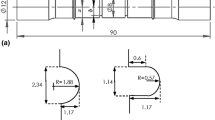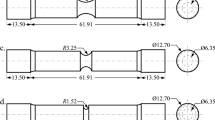Abstract
The present paper proposes ductile failure criteria in terms of true fracture strain (the equivalent strain to fracture) as a function of the stress triaxiality (defined by the ratio of the hydrostatic stress to the equivalent stress) for the API X65 steel. To determine the stress-modified fracture strain, smooth and notched tensile bars with four different notch radii are tested, from which true fracture strains are determined as a function of the notch radius. Then detailed elastic–plastic, large strain finite element analyses are performed to estimate variations of stress triaxiality in the tensile bars, which leads to true fracture strains as a function of the stress triaxiality, by combining them with experimental results. Two different failure criteria are proposed, one based on local stress and strain information at the site where failure initiation is likely to take place, and the other based on averaged stress and strain information over the ligament where ductile fracture is expected. As a case study, ligament failures of API X65 pipes with a gouge are predicted and compared with experimental data.
Similar content being viewed by others
References
Alves M, Jones N (1999) Influence of hydrostatic stress on failure of axisymmetric notched specimens. J Phys Mech Solids 47:643–667
American Petroleum Institute (2000) Specification for line pipe
American Society of Mechanical Engineers (1992) ASME Boiler and Pressure Vessel Code Section IX
Anderson TL (1995) Fracture mechanics—fundamentals and applications. CRC Press
Bao Y (2005) Dependence of ductile crack formation in tensile test on stress triaxiality, stress and strain ratios. Eng Fract Mech 72:505–522
Bao Y, Wierzbicki T (2004) On fracture locus in the equivalent strain and stress triaxiality space. Int J Mech Sci 46:81–98
Beremin FM (1981) Cavity formation from inclusions in ductile fracture of A 508 steel. Metall Trans 12A:723–731
Bernauer G, Brocks W (2002) Micro-mechanical modeling of ductile damage and tearing-results of a European numerical round robin. Fatigue Fract Eng Mater Struct 25:363–384
Bridgman P (1952) Studies in large plastic flow and fracture. McGraw-Hill Book Company Inc., New York
Chen Y, Lambert S (2003) Analysis of ductile tearing of pipeline-steel in single edge notch tension specimen. Int J Fract 124:179–199
Chu C, Needleman A (1980) Void nucleation effects in biaxially stretched sheets. J Eng Mater Technol 102:249–256
Clausing DP (1970) Effect of plastic strain state on ductility and toughness. Int J Fract Mech 6:71–85
Cosham A, Hopkins P (2004) The effect of dents in pipelines-guidance in the pipeline defect assessment manual. Int J Pressure Vessels Piping 81:127–139
Garrison WR Jr, Moody NR (1987) Ductile fracture. J Phys Chem Solids 48:1035–1074
Dotta F, Ruggieri C (2004) Structural integrity assessments of high pressure pipelines with axial flaws using a micromechanics model. Int J Pressure Vessels Piping 81:761–770
Gurson AL (1977) Continuum theory of ductile rupture by void nucleation and growth—yield criteria and flow rules for porous ductile media. J Eng Mater Technol 99:2–15
Hancock JW, Mackenzie A (1976) On the mechanisms of ductile failure in high-strength steels subject to multi-axial stress states. J Phys Mech Solids 24:147–169
Hancock JW, Cowling MJ (1980) Role of state of stress in crack-tip failure processes. Metal Sci 293–304
Hibbitt, Karlson & Sorensen Inc. (2005) ABAQUS Version 6.4 user’s manual
Kanninnen MF, Zahoor A, Wilkoski G et al (1982) Instability predictions for circumferentially cracked Type-304 stainless pipes under dynamic loading. EPRI report NP-2347, Electric Power research Institute, Palo Alto, USA
Kim YJ, Oh CK, Myung MS, et al (2006) Fully plastic analyses for notched bars and plates using finite element limit analysis. Eng Fract Mech 73:1849–1864
Koplik J, Needleman A (1988) Void growth and coalescence in porous plastic solids. Int J Solids Struct 24:835–853
La Losa G, Mirone G, Risitano A (2001) Effect of stress triaxiality corrected plastic flow on ductile damage evolution in the framework of continuum damage mechanics. Eng Fract Mech 68:417–434
La Losa G, Mirone G, Risitano A (2003) Postnecking elastoplastic characterization: degree of approximation in the Bridgman method and properties of the flow-stres/true-stress ratio. Metall Mater Trans A Phys Metall Mater Sci 34:615–624
Mackenzie A, Hancock JW, Brown D (1977) On the influence of state of stress on ductile failure initiation in high strength steels. Eng Fract Mech 9:167–188
McClintock FA (1968) A criterion of ductile fracture by the growth of holes. J Appl Mech 35:363–371
Oh CK, Kim YJ, Baek JH (2006) A micro-mechanical model of ductile fracture of API X65 steels and application to pre-strain effects on deformation and fracture. Int J Mech Sci (submitted)
Rice JR, Tracey DM (1969) On the ductile enlargement of voids in triaxial stress fields. J Phys Mech Solids 17:201–217
Ritchie RO, Thompson AW (1985) On macroscopic and microscopic analyses for crack initiation and crack growth toughness in ductile alloys. Metall Trans A 16A:233–248
Rivalin F, Besson J, Pineau A, Di Fant M (2001) Ductile tearing of pipeline-steel wide plates II-modeling of in-plane crack propagation. Eng Fract Mech 68:347–364
Rousselier G. (1987) Ductile fracture models and their potential in local approach of fracture. Nucl Eng Design 105:97–111
Schiffman R, Bleck W, Dahl W (1998) The influence of strain history on ductile failure of steel. Comput Mater Sci 13:142–147
Schluter N, Grimpe F, Bleck W et al (1996) Modeling of the damage in ductile steels. Comput Mater Sci 7:27–33
Theocaris PS (1995) Failure criteria for isotropic bodies revisited. Eng Fract Mech 51:239–264
Thomason PF (1990) Ductile fracture of metals. Pergamon Press, Oxford, UK
Tvergaard V (1981) Influence of voids on shear band instabilities under plane strain conditions. Int J Fract 17:389–407
Tvergaard V (1982) On localization in ductile materials containing spherical voids. Int J Fract 18:237–252
Tvergaard V, Needleman A (1982) Analysis of the cup-cone fracture in a round tensile bar. Acta Metall 32:157–169
Valiente A (2001) On Bridgman’s stress solution for a tensile neck applied to axisymmetrical blunt notched tension bars. J Appl Mech 68:412–419
Wilkoski G, Stephens D, Krishnaswamy P, et al (2000) Progress in development of acceptance criteria for local thinned areas in pipe and piping components. Nucl Eng Design 195:149–169
Zuo J, Sutton MA, Deng X (2004) Basic studies of ductile failure processes and implications for fracture prediction. Fatigue Fract Eng Mater Struct 27:231–243
Author information
Authors and Affiliations
Corresponding author
Rights and permissions
About this article
Cite this article
Oh, CK., Kim, YJ., Baek, JH. et al. Development of stress-modified fracture strain for ductile failure of API X65 steel. Int J Fract 143, 119–133 (2007). https://doi.org/10.1007/s10704-006-9036-3
Received:
Accepted:
Published:
Issue Date:
DOI: https://doi.org/10.1007/s10704-006-9036-3




